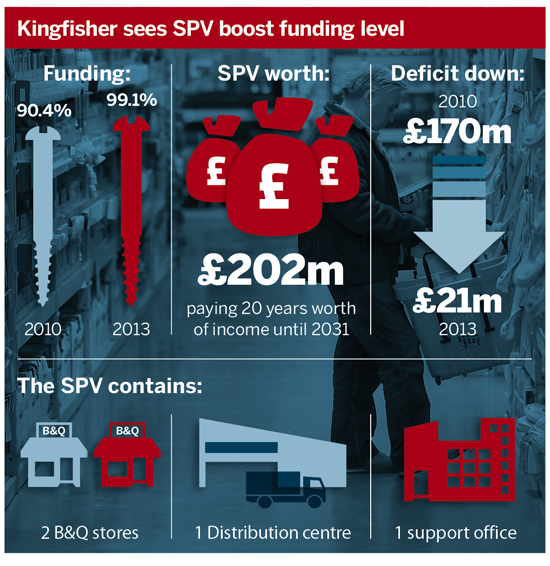Kingfisher Pension Scheme has revealed that a funding deal with its sponsor, which sees it draw from income-generating properties, has pushed its funding level close to 100 per cent.
The owner of DIY retailers B&Q and Screwfix placed two of its stores into a Scottish limited partnership, alongside a distribution centre and a support office. The partnership was set up to provide the scheme with an income for a 20-year period, ending in 2031.

Kingfisher’s deficit reduced to £21m in 2013 from £170m in 2010 as a result of the special purpose vehicle and employer contributions. This increased its funding level to 99.1 per cent from 90.4 per cent in the same period, according to the scheme’s 2013 valuation update.
The SPV comprises 9 per cent of the scheme’s 2013 asset allocation. “The benefit to the trustees is that they get the rental income from these assets which gives a bond-like income,” said Dermot Courtier, head of group pensions at Kingfisher.
The partnership was set up in the wake of the scheme’s 2010 valuation as a means of closing the scheme’s technical provisions deficit.
It was implemented in two stages. Property worth £83m was sold to the partnership in January 2011 before being leased back to B&Q. Further properties with a combined value of £119m were then transferred to the partnership in June of the same year.
Courtier said the scheme carried out the exercise after becoming aware of a growing trend of SPV use among similar employers. “We were conscious some of the other big retailers were looking at it,” he said.
Ringfencing assets
SLPs and other forms of asset-backed funding structures have grown in popularity in recent years.
Vicky Carr, partner at law firm Sackers, said the scheme gets a “ringfenced” asset pool. She added: “The trustee is a partner in the limited partnership and so can take control of the partnership and assets if the employer becomes insolvent.”
She added: “They’ve traditionally been the preserve of larger schemes but have trickled down to smaller schemes and smaller deficits.”
Siemens Pension Scheme also recently used a Scottish limited partnership to boost its funding level. Asset-backed funding can reduce the amount of a scheme has to pay in Pension Protection Fund levies, although new proposals have indicated that only structures containing UK property assets will lead to a reduction.
James Atherton, partner at consultancy LCP, said: “Their proposal is unless the asset is UK property, they won’t allow you any credit. If you have a partnership structure with UK property you should still get the benefit of the PPF.”
Many private sector employers have been actively looking for ways to reduce their pension fund risks. Telecoms giant BT last week entered into a longevity swap which will cover £16bn of its liabilities.














